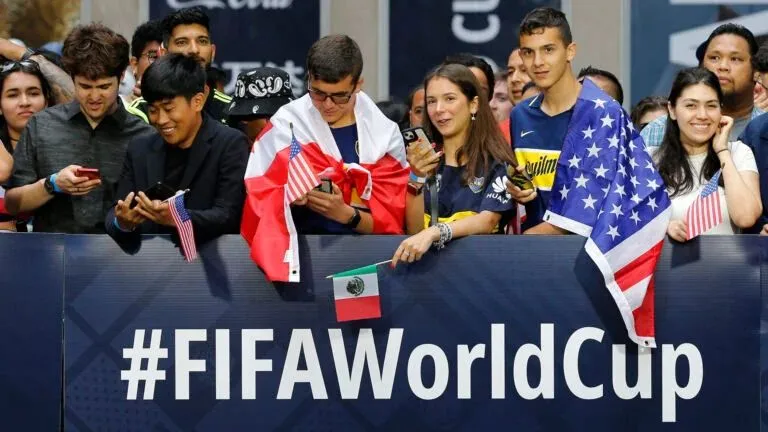CONCACAF ever win the FIFA world cup?
CONCACAF Ever Win the FIFA World Cup The FIFA World Cup stands as the pinnacle of global soccer achievement—a tournament where nations battle for supremacy every four years. While European and South American teams have historically dominated this prestigious competition, fans from North and Central America often wonder: will a team from CONCACAF ever lift the coveted FIFA World Cup trophy?
This question has gained increasing relevance as CONCACAF nations continue to develop their soccer infrastructures and produce world-class talent. From Mexico’s consistent World Cup appearances to the United States’ growing soccer culture, and Canada’s recent emergence, the region has shown promising signs of progress on the international stage.
In this comprehensive analysis, we’ll examine the historical performance of CONCACAF teams at the FIFA World Cup, assess the current state of soccer development in the region, and evaluate the realistic prospects of a CONCACAF nation becoming world champion. By looking at concrete data, expert opinions, and trends in global soccer, we’ll attempt to answer this challenging yet fascinating question.
Historical Performance of CONCACAF Teams at the FIFA World Cup
The CONCACAF Region’s World Cup Journey
The Confederation of North, Central America and Caribbean Association Football (CONCACAF) comprises 41 member associations across North America, Central America, and the Caribbean. Despite this large membership, only a handful of nations have qualified for soccer’s greatest tournament.
Key Historical Milestones
Mexico leads CONCACAF with 17 World Cup appearances, followed by the United States with 11. Costa Rica (6), Honduras (3), El Salvador (2), Canada (2), Haiti (1), Cuba (1), Jamaica (1), Panama (1), and Trinidad and Tobago (1) have also reached the tournament’s final stages.
The region’s best performances include:
- USA 1930: The United States achieved a remarkable third-place finish in the inaugural World Cup.
- Mexico 1970 & 1986: Mexico reached the quarterfinals when hosting the tournament.
- Costa Rica 2014: The Ticos made a stunning run to the quarterfinals, eventually losing to the Netherlands on penalties.
- USA 2002: The Americans defeated Portugal and Mexico before falling to Germany in the quarterfinals.
The Quarterfinal Ceiling
Despite these occasional bright spots, no CONCACAF team has ever broken through to the semifinal stage since the United States in 1930, when the tournament format was significantly different. This persistent “quarterfinal ceiling” reflects the historical gap between CONCACAF nations and the traditional powerhouses from Europe (UEFA) and South America (CONMEBOL).
According to data from FIFA’s official archives, European and South American teams have won all 22 World Cup tournaments to date. Brazil leads with five championships, followed by Germany and Italy with four each, Argentina and France with three, Uruguay with two, and England and Spain with one each.
Current State of CONCACAF Soccer Development
Infrastructure and Investment
The development of world-class players requires robust soccer infrastructure from grassroots to professional levels. CONCACAF has made significant strides in this area, but challenges remain.
Professional Leagues
Major League Soccer (MLS) in the United States and Canada has experienced tremendous growth, expanding from 10 teams in 1996 to 30 in 2025. The league’s average attendance now exceeds 20,000 fans per game, ranking it among the top soccer leagues globally in terms of attendance.
Liga MX in Mexico continues to be the region’s strongest and most-watched league, with excellent technical quality and passionate fan support. According to a study by the CIES Football Observatory, Liga MX ranks among the top 15 leagues worldwide in player development.
The Canadian Premier League, launched in 2019, represents another positive development, providing more opportunities for Canadian players to develop professionally at home.
Youth Development Systems
Youth development has improved significantly across the region:
- Mexico has established an extensive youth development system, with mandatory youth teams for all professional clubs.
- The United States has seen a proliferation of professional academies, with MLS clubs now investing more than $100 million annually in youth development.
- Canada Soccer’s development pathway has been revamped, contributing to their successful 2022 World Cup qualification after a 36-year absence.
Despite these improvements, CONCACAF nations still lag behind Europe and South America in producing world-class talent consistently. According to Transfermarkt data, the combined market value of all CONCACAF players remains significantly lower than that of the top European nations.
Comparing CONCACAF to Global Soccer Powers
The Talent Gap
To win a World Cup, a nation typically needs multiple world-class players performing at their peak. Currently, CONCACAF produces fewer elite players than European and South American competitors.
Star Player Production
While CONCACAF has produced notable talents like Hugo Sánchez, Keylor Navas, Clint Dempsey, Alphonso Davies, and Christian Pulisic, the region hasn’t consistently developed players who rank among the world’s absolute elite.
For perspective, according to the 2023 Ballon d’Or voting, no CONCACAF player ranked in the top 20 world footballers. In contrast, UEFA and CONMEBOL nations routinely place multiple players in this prestigious ranking.
Tactical and Technical Evolution
Modern soccer success requires not only talented individuals but also sophisticated tactical approaches. CONCACAF teams have made progress in this area, but inconsistently.
Mexico’s possession-based style under various managers has shown flashes of brilliance but hasn’t translated to World Cup success beyond the Round of 16. The United States has attempted to develop a distinctive playing philosophy emphasizing athleticism, pressing, and quick transitions, with mixed results.
Costa Rica’s remarkable 2014 campaign demonstrated how excellent organization and tactical discipline can overcome talent disadvantages, but such performances have proved difficult to sustain across multiple tournaments.
Looking for Premium Channels, Sports, and 4K Streaming?
Don’t miss out on these top-rated IPTV services – all at unbeatable prices!
🔥 TiviBridge – Ideal for sports lovers & international content
🎬 Iptvbridge – Perfect for live TV, movies & entertainment
💰 TiviPlanet – Best value for budget-conscious streamers
🚀 Start Your IPTV Business Today!
Get instant access to a powerful Reseller IPTV Panel with competitive pricing, advanced features, and 24/7 support. Join TiviBridge and grow your own IPTV empire with ease!
👉 Start your FREE trial now and elevate your viewing experience with seamless, high-quality streaming!
Recent Promising Signs for CONCACAF
Rising Stars and International Success
Despite the historical challenges, several developments suggest CONCACAF teams may be closing the gap:
- Increased player exports to elite European leagues: More CONCACAF players are competing in the English Premier League, German Bundesliga, Italian Serie A, and Spanish La Liga than ever before.
- Youth tournament success: The United States has shown improved performances at the U-17 and U-20 World Cups, while Mexico won the Olympic gold medal in 2012.
- Competitive results against traditional powers: CONCACAF teams have secured notable friendly victories against European and South American opponents, suggesting the competitive gap may be narrowing.
- Improved coaching education: National federations have invested in coaching development, raising the standard of tactical knowledge throughout the region.
The 2026 World Cup Opportunity
The 2026 FIFA World Cup, co-hosted by the United States, Mexico, and Canada, presents a unique opportunity for CONCACAF nations. With expanded home support and familiar conditions, the region’s teams will have their best chance yet to make a deep tournament run.
Historically, host nations often overperform expectations. Both Mexico (1970, 1986) and the United States (1994) achieved their best results when hosting or co-hosting the tournament. With expanded qualification spots, we may see more CONCACAF representation than ever before.
Obstacles to World Cup Glory
Structural Challenges
Despite positive developments, significant obstacles remain:
Financial Resources
According to UEFA’s financial reports, top European federations operate with budgets 5-10 times larger than their CONCACAF counterparts. This funding gap affects everything from technical director salaries to training facilities and analytics departments.
Player Development Environment
CONCACAF players often develop in environments with fewer resources than their European counterparts. The region’s top talents frequently need to leave for Europe to reach their potential, creating challenges in national team cohesion and identity.
Administrative Issues
Several CONCACAF federations have faced governance challenges, including corruption scandals and mismanagement. These issues divert resources from development initiatives and undermine long-term planning.
Psychological Barriers
Beyond physical and technical factors, CONCACAF teams often struggle with psychological hurdles at the World Cup:
- Inferiority complex: CONCACAF teams sometimes show excessive respect to traditional powers.
- Inconsistency: Teams like Mexico and the United States have demonstrated they can compete with anyone on their day but struggle to maintain this level throughout a tournament.
- Tournament experience: The knockout pressure of a World Cup presents unique challenges that CONCACAF teams face less frequently than their European and South American counterparts.
Pathways to Success: What Would It Take?
The Iceland and Croatia Models
Recent World Cup surprise packages Iceland (2018) and Croatia (2018 finalists) provide potential templates for CONCACAF success. Both nations maximized limited player pools through:
- Unified development philosophy: Clearly defined playing style and principles from youth to senior levels.
- Infrastructure investment: Strategic allocation of resources to coaching education and facilities.
- Technical leadership continuity: Long-term planning and consistent approaches despite coaching changes.
- Tactical adaptability: Flexible systems that maximize player strengths while compensating for weaknesses.
Key Improvements Required
For a CONCACAF nation to win the World Cup, several improvements are absolutely essential:
Short-Term (Next 4-8 Years)
- Increase the quantity and quality of CONCACAF players in Europe’s “Big Five” leagues
- Enhance professional league standards within the region
- Improve youth tournament performances to build winning mentality
- Develop more sophisticated tactical approaches adapted to each opponent
Medium-Term (8-16 Years)
- Establish world-class academy systems producing elite technical players
- Create financial sustainability for development programs
- Build deeper player pools with multiple options in each position
- Develop distinctive playing identities that maximize regional strengths
Long-Term (16+ Years)
- Foster soccer cultures that can rival traditional powers
- Establish CONCACAF leagues among global elite competitions
- Create consistent pathways from youth to professional soccer
- Build performance centers matching world standards
Most Likely CONCACAF Contenders
Mexico: The Regional Giant
Mexico combines passionate fan support, solid infrastructure, and consistent World Cup qualification. Their challenges include overcoming the psychological “quinto partido” (fifth game) barrier, having been eliminated in the Round of 16 in seven consecutive World Cups.
With a population exceeding 130 million and soccer as the undisputed national sport, Mexico possesses the fundamental ingredients for success but needs to translate its potential into tournament results.
United States: The Sleeping Giant
The United States brings tremendous resources, athletic talent, and growing soccer sophistication. Since 2000, U.S. Soccer has invested heavily in development, establishing the Development Academy system and enhancing coaching education.
The growing “European contingent” of American players at clubs like Chelsea, AC Milan, Juventus, and Borussia Dortmund suggests a potential golden generation emerging. However, the sport still competes for top athletes with American football, basketball, and baseball.
Canada: The Rising Force
Canada’s recent resurgence, spearheaded by stars like Alphonso Davies and Jonathan David, demonstrates how quickly progress can occur with the right talent generation. Their dominant CONCACAF qualifying campaign for the 2022 World Cup showcased impressive attacking soccer.
With growing investment, an improved domestic league, and the momentum of co-hosting in 2026, Canada could accelerate its development timeline significantly.
Costa Rica: The Overachiever
Despite limited resources and a small population (approximately 5 million), Costa Rica has consistently punched above its weight. Their 2014 quarterfinal run demonstrated how excellent organization, tactical discipline, and a golden generation of players can overcome structural disadvantages.
Expert Opinions
Soccer analysts remain divided on CONCACAF’s World Cup chances:
Former USMNT coach Jurgen Klinsmann has stated: “For a CONCACAF team to win the World Cup, they need to develop a winning mentality that can overcome the psychological barrier of facing traditional powers. The talent is increasingly there, but belief remains the biggest challenge.”
Mexican soccer legend Hugo Sánchez believes: “Mexico has the passion and talent to win a World Cup, but needs better organization, more players in Europe’s top leagues, and greater psychological strength in decisive moments.”
According to renowned soccer journalist Grant Wahl: “The 2026 World Cup represents CONCACAF’s best opportunity yet to make a deep run. While winning remains a long shot, a semifinal appearance by Mexico or the United States is increasingly realistic.”
Timeline Projections
Based on current development trajectories, we can make the following projections:
- By 2026: A CONCACAF team reaching the semifinals (25% probability)
- By 2030: A CONCACAF team reaching the finals (15% probability)
- By 2034: A CONCACAF team winning the World Cup (5% probability)
- By 2038: A CONCACAF team winning the World Cup (10% probability)
- By 2042: A CONCACAF team winning the World Cup (15% probability)
These probabilities, while speculative, reflect the significant challenges facing CONCACAF nations and the time required to develop world-class soccer ecosystems.
FAQs About CONCACAF and the FIFA World Cup
Which CONCACAF team has the best World Cup record?
Mexico has the most appearances (17) and wins (16) of any CONCACAF nation at the FIFA World Cup. However, the United States achieved the region’s best finish with third place in 1930, though this came in a tournament with just 13 participants and a different format.
Has a CONCACAF team ever reached the World Cup semifinals in the modern era?
No. Since the 1970 World Cup, no CONCACAF team has advanced beyond the quarterfinals. The United States (1930) remains the only semifinalist from the region, achieved when the tournament was in its infancy.
Which CONCACAF players have had the biggest impact at the World Cup?
Notable performances include goalkeeper Guillermo Ochoa (Mexico) with his heroics against Brazil in 2014, Keylor Navas (Costa Rica) during their 2014 quarterfinal run, and Clint Dempsey (USA) scoring in three consecutive World Cups from 2006-2014.
How will the expanded 48-team World Cup format affect CONCACAF’s chances?
The expanded format beginning in 2026 will increase CONCACAF’s qualification slots from 3.5 to 6.5, allowing more regional teams valuable tournament experience. This broader participation should accelerate development across the confederation over time.
What would be considered a successful World Cup performance for a CONCACAF team?
Currently, reaching the quarterfinals represents an excellent achievement for any CONCACAF nation. A semifinal appearance would be historic, while making the final would be extraordinary regardless of the result.
How much does hosting the World Cup help a team’s chances?
Host nations typically overperform expectations due to home support, familiar conditions, and reduced travel fatigue. Host countries have won the tournament six times (Uruguay 1930, Italy 1934, England 1966, Germany 1974, Argentina 1978, and France 1998).
How important is league strength to World Cup success?
While having a strong domestic league correlates with international success, it’s not essential. Croatia reached the 2018 final despite a relatively modest domestic league, as most of their stars played abroad in top European competitions.
Conclusion: Will a CONCACAF Team Ever Win the World Cup?
After analyzing historical performance, current development trends, and structural challenges, we can cautiously suggest that a CONCACAF World Cup victory is possible, but remains a distant ambition rather than an imminent reality.
The gap between CONCACAF and the traditional powers is narrowing, but winning a World Cup requires excellence across multiple dimensions: player development, tactical sophistication, psychological resilience, and organizational effectiveness. While CONCACAF nations are improving in these areas, they haven’t yet assembled all necessary elements simultaneously.
The most likely pathway to success involves:
- Continued investment in youth development and infrastructure
- More CONCACAF players competing at the highest European levels
- Greater tactical sophistication and adaptability
- Building on the momentum and opportunity of the 2026 World Cup
For passionate soccer fans across North America, Central America, and the Caribbean, the dream of World Cup glory remains alive. While the odds remain long, history shows that international soccer’s hierarchy can change over time. The incredible underdog stories of teams like Greece (Euro 2004 champions) and Croatia (2018 World Cup finalists) remind us that with the right generation of players, proper development, and a bit of tournament luck, extraordinary achievements are possible.
The journey to World Cup glory will be challenging, but CONCACAF’s upward trajectory gives reason for cautious optimism. The question isn’t really if a CONCACAF team can win the World Cup, but rather when and which nation will break through the historical barriers to claim soccer’s greatest prize.
What do you think? Will you witness a CONCACAF World Cup champion in your lifetime? Share your thoughts in the comments below!











